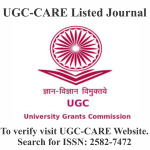THE POLITICS OF DESIRE: MALE AGGRESSION AND FEMALE AGENCY IN POST-LIBERALIZATION HINDI CINEMA
DOI:
https://doi.org/10.29121/shodhkosh.v5.i5.2024.6528Keywords:
Gender Representation, Romantic Film, Sexual Harassment, Patriarchy, BollywoodAbstract [English]
This paper critically examines the representation of sexual harassment and coercion in 1990s Hindi cinema, a decade often celebrated for its romantic and family-oriented narratives. While Bollywood’s romantic films of this decade foregrounds love and youthful desire, they simultaneously embedded subtle forms of sexual violence, such as stalking, eve-teasing and coercive advances within courtship rituals. Drawing on feminist film theory and Laura Mulvey’s concept of the “male gaze,” the study argues that these cinematic portrayals blurred the line between romance and harassment, presenting male aggression as endearing and female resistance as coyness destined to yield to persistence. Through textual analysis of popular films, this paper highlights how Bollywood constructed a hierarchy of sexual violence, extreme acts like rape were demonised when committed by villains, while “moderate” acts of harassment by heroes were normalised, trivialised and celebrated. The paper argues that these representational strategies not only reinforced patriarchal ideologies but also shaped cultural perceptions of romance, agency and gender roles. The paper underscores how 1990s Hindi cinema functioned as an ideological apparatus that legitimized coercion as love and perpetuated gendered hierarchies.
References
Chakravorty, N. (2024). Portrayal and perception of male chauvinism and gender superiority in Hindi cinema. DOI: https://doi.org/10.58966/JCM20243112
Chakravarty, S. S. (1993). National identity in Indian popular cinema, 1947–1987. University of Texas Press. DOI: https://doi.org/10.7560/755512
Cohen, J. (2001). A theoretical look at the identification of audiences with media characters. Mass Communication & Society, 4(3), 245–264. https://doi.org/10.1207/S15327825MCS0403_01 DOI: https://doi.org/10.1207/S15327825MCS0403_01
Dudrah, R. K. (2006). Bollywood: Sociology goes to the movies. Sage Publications.
Dwyer, R. (2006). Bollywood's India: A public fantasy. Reaktion Books.
Ganti, T. (2004). Bollywood: A guidebook to popular Hindi cinema. Routledge.
Ganti, T. (2012). Producing Bollywood: Inside the contemporary Hindi film industry. Duke University Press. DOI: https://doi.org/10.1515/9780822395225
Gokulsing, K. M., & Dissanayake, W. (2004). Indian popular cinema: A narrative of cultural change (2nd ed.). Trentham Books.
Gupta, U., & Roy, R. (2019). Portrayal of sexual aggression in Hindi cinema. International Journal of Emerging Technologies and Innovative Research, 6(4), 180–183.
Hall, S. (1980). Encoding/decoding. In S. Hall, D. Hobson, A. Lowe, & P. Willis (Eds.), Culture, media, language: Working papers in cultural studies, 1972–79 (pp. 128–138). Hutchinson.
Kapur, R. (2012). Erotic justice: Law and the new politics of postcolonialism. Routledge. DOI: https://doi.org/10.4324/9781843146193
Karnad, R. M. (2023). Stalking: A crime normalized by Bollywood. International Journal for Multidisciplinary Research, 5(6). DOI: https://doi.org/10.36948/ijfmr.2023.v05i06.10500
Majumder, P. (2014). Impact of Hindi films on society: A study on portrayal of crimes against women. Manipal University.
Mazumdar, R. (2007). Bombay cinema: An archive of the city. University of Minnesota Press.
Rajadhyaksha, A. (2009). Indian cinema in the time of celluloid: From Bollywood to the Emergency. Indiana University Press. DOI: https://doi.org/10.2979/5466.0
Rajendran, S. (2019, June 29). 8 real life nightmarish scenarios for women which pass as love or comedy in cinema. The News Minute. https://www.thenewsminute.com/article/8-real-life-nightmarish-scenarios-women-which-pass-love-or-comedy-cinema-104322
Ramasubramanian, S., & Oliver, M. B. (2003). Portrayals of sexual violence in popular Hindi films, 1997–99. Sex Roles, 48(7–8), 327–336. https://doi.org/10.1023/A:1022938513819 DOI: https://doi.org/10.1023/A:1022938513819
Rana, U. (2023). Are we safe? An investigation of eve-teasing (public sexual harassment) in India. Journal of International Women's Studies, 25(7), Article 7. DOI: https://doi.org/10.31235/osf.io/3y9u6
Sharma, N., & Tripathi, P. (2023). Scripting justice: Intersecting law, culture, and gender in Hindi cinema’s portrayal of domestic violence. HyperCultura, 12, 1–16.
Tamakuwala, S. J. (2017). Victimhood of women under patriarchy: Some reflections from Bollywood movie ‘Pink’. Research Journal of Philosophy & Social Sciences, 43(1), 80–88.
Virdi, J. (2003). The cinematic imagination: Indian popular films as social history. Rutgers University Press.
Downloads
Published
How to Cite
Issue
Section
License
Copyright (c) 2024 Johnson Rajkumar

This work is licensed under a Creative Commons Attribution 4.0 International License.
With the licence CC-BY, authors retain the copyright, allowing anyone to download, reuse, re-print, modify, distribute, and/or copy their contribution. The work must be properly attributed to its author.
It is not necessary to ask for further permission from the author or journal board.
This journal provides immediate open access to its content on the principle that making research freely available to the public supports a greater global exchange of knowledge.




















